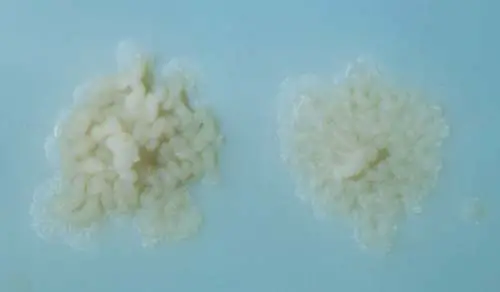Lowenstein Jensen Medium (LJ Medium) is a selective medium that is commonly used for the cultivation and isolation of Mycobacterium (notably Mycobacterium tuberculosis) from specimens containing mixed flora.
Mycobacterium tuberculosis is a pathogenic bacterial species in the family Mycobacteriaceae and the causative agent of most cases of tuberculosis. The medium is light green in color with solid consistency.
Principle
Lowenstein-Jensen Medium is commonly used in the clinical laboratory to isolate acid fast organisms from sterile and non sterile sources. LJ Medium was originally formulated by Lowenstein, containing congo red and malachite green dyes. Jensen modified Lowenstein’s medium by altering the citrate and phosphate contents, eliminating the congo red dye and by increasing the malachite green concentration.
L-Asparagine and Potato Flour are sources of nitrogen and vitamins in Lowenstein-Jensen Medium. Monopotassium Phosphate and Magnesium Sulfate enhance organism growth and act as buffers. Glycerol and the Egg Suspension provide fatty acids and protein required for the metabolism of mycobacteria.
When heated, the egg albumin coagulates, thus providing a solid surface for inoculation. Glycerol serves as a carbon source and is favorable to the growth of the human type tubercle bacillus while being unfavorable to the bovine type. Malachite green acts as an inhibitory agent toward microorganisms other than mycobacteria.
Composition
- LJ Medium Base :
L-Asparagine = 3.6 g
Monopotassium Phosphate = 2.5 g
Magnesium Sulfate = 0.24 g
Sodium Citrate = 0.6 g
Malachite Green = 0.4 g
Potato Flour = 30 g - Supplements:
Glycerol = 12 ml
Egg suspension = 1000 ml
Preparation
- Dissolve 37.3 g of the medium in 600 mL of purified water containing 12 mL of glycerol.
- Heat with frequent agitation to completely dissolve the medium.
- Autoclave at 121°C for 15 minutes.
- Prepare 1000 mL of a uniform suspension of fresh eggs under aseptic conditions. Avoid whipping air into suspension during the collection and mixing.
- Aseptically mix the 1000 mL of egg suspension with 600 mL of the sterile Lowenstein-Jensen Medium cooled to 50 – 60°C, avoiding air bubbles.
- Dispense the finished medium into sterile screw-cap test tubes. Place the tubes in a slanted position and heat at 85°C for 45 minutes.
Method of Use
- Inoculate the Lowenstein Jensen Media with specimen after decontamination and neutralization.
- Incubate medium in a CO2 atmosphere at 35-37°C. Protect from light. Tubed media should be incubated for one week with loosened caps to allow the circulation of CO2 for the initiation of growth. Caps should be tightened after one week in order to prevent dehydration of media.
- Examine the media within five to seven days, and weekly thereafter for up to eight weeks.
- Examine plates under light for the appearance of macroscopic growth.
- Examine tubes under light and magnifying mirror for macroscopic growth. Record and describe colony morphology on the first day growth is observed.
- Consult appropriate references for recording the number of colonies and for aid in the biochemical identification of acid-fast bacilli.
Result Interpretation
Observe for colonies that may or may not be pigmented. Colony morphology depends on the species isolated. The picture below shows Mycobacterium tuberculosis colonies on LJ Medium.



Great job DHURBA GIRI
My research is on mycobacterium avium complex. I prepared LJ medium ie 9.3g LJ medium in 150 ml sterile water added 3 ml glycerol and 250 ml fresh egg emulsion. I put the slants in an oven for 45 minute at 80C but for the second time my media did not coagulted properly. water vapors are seen on empty wal of the bottle. please guide for preparation
I have two questions.
Q1. What is water of condensation?
Q2. Why is LJ medium stored in a bottle?